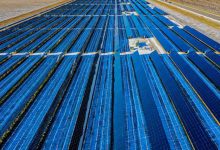Misinformation isn’t a new thing.
Perhaps (arguably) lies spread faster than they once did, catalysed by algorithmic machines created by Big Tech. But this narrative takes focus away from the massive and hulking old-school coal-powered engine of misinformation that is Australia’s old media landscape.
Renewable energy as a topic is the perfect mix of technical impenetrability and political melodrama to serve as clear illustration of the transmissibility of a morsel of bullshit in this system of publication and re-publication.
On Monday, the Australian’s front page blared two specific figures very clearly: Australia’s small-scale solar subsidy scheme would cost, in total, $2 billion, and for each household, that works out to $195 this year.
 This morsel of news spread quickly. Those are big numbers, and media outlets with an editorial antagonism towards clean energy and climate action lapped it up in rapid succession, broadcast to (and read by) millions (full list with links here):
This morsel of news spread quickly. Those are big numbers, and media outlets with an editorial antagonism towards clean energy and climate action lapped it up in rapid succession, broadcast to (and read by) millions (full list with links here):
(See RenewEconomy’s initial take on it here: Murdoch media attacks rooftop solar, gets its numbers horribly wrong).
Why it’s catastrophically wrong
First up, for some reason, most media outlets round-up the range of $1.5bn to $1.7bn up to $2bn, which is an easy $300m chucked on the end. You can see why that’s wrong. But what about the household cost?
The Australian Energy Markets Commission makes a habit of publishing a break-down of the things that make up residential electricity bills in Australia.
The chart below is taken from their latest report, and it shows how much the scheme contributes to electricity bills. Spoiler alert – it’s $34 a year, or about 2% of your damn bill, which is really tiny.
That’s just under six times smaller than the figure reported widely across Australian media on Monday.
Or, to illustrate it more clearly:
So, how did the rule-maker for Australian electricity markets get one figure, and Australia’s media outlets got one six times bigger?
It’s a trap
Part of the answer lies in a weirdly similar article from roughly this time last year, in which the author of the report referenced says:
“The cost increase (this year) is about $800m and there are 8 million households … so there’ll be a cost impact of around $100 per household. The electricity impact might be $40 or $50 per household but businesses will pass through the additional cost too … That subsidy of $500m last year, or $1.2bn to $1.3bn this year, is added on to everyone’s bills”
Electricity in Australia isn’t just consumed by people in homes. Businesses, with offices and factories, buy and consume electricity too – and they also pay a percentage of their bill towards this particular scheme. Homes aren’t even the majority, as shown in the grid operator’s forecasting report:
The logic in this quote is that businesses must pass on all electricity costs to the people who buy their stuff (who also lives in homes). Therefore, all ‘Businesses’ costs apply entirely to all ‘household’ costs.
Presumably, the journalist has used this same logic for this year’s annual ‘the solar subsidies are too high’ article – chucking only the SRES component of businesses costs, and weirdly assuming that all businesses pass 100% of that component through to each household in equal proportion.
The trick being deployed here is that an entire column of has been added to the calculations, but they’re slicing out the solar parts, adding them together, and trying very hard to ignore the pathologically weird implications of saying that every single cost paid by every single business counts as a household cost for every home.
The reason this came up in March last year, and the reason it’s come up again roughly the same time, is explained well at Solar Quotes:
“Even though Australia’s major solar subsidy is already being gradually phased out, a rebound in STC [small-scale technology certificate] prices after they plummeted during a period last year has significantly reduced the out-of-pocket cost of installing solar power systems.
However, STC value can also be influenced by the Small-scale Technology Percentage (STP), which is meant to balance the supply of STCs by setting an equivalent demand each year. This percentage is set annually by the Energy Minister and must be announced by the end of March”
That’s a lot of energy nerd jargon, but basically, it’s a knob that, when twisted, changes the quantity of money that people installing solar power will get for every unit of energy they create, and it’s set to be potentially twisted in a few weeks.
Misconceptions and misinformation aren’t uncommon in this debate.
But occasionally, something that’s just really, really wrong comes along, and it’s mind-boggling to see how it replicates instantly, first across media outlets, and then into the climate denier blogosphere.
There’s basically nothing an ordinary citizen can do to stop it.
Despite the author conditionally acknowledging the reporting was wrong, no effort seems to have been made to set the record straight, and media outlets are still re-posting the story at the time of writing.
In a media landscape in which all of the social and financial costs of major errors are paid by citizens and society, not by media outlets, these errors are free to emerge and replicate on a daily basis.
Whatever the merits or shortfalls of Australia’s solar subsidy scheme, this particular screw-up was big, and resulted in misinforming many, many people.
This story was originally published on Ketan Joshi’s personal blog. Reproduced with permission of the author. Please also note our story: : Murdoch media attacks rooftop solar, get’s numbers horribly wrong).
















